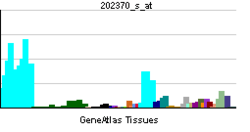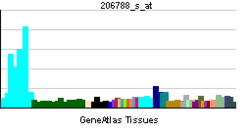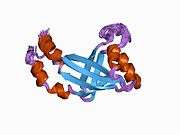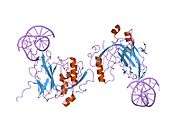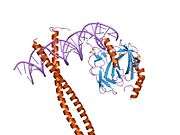CBFB
| View/Edit Human | View/Edit Mouse |
Core-binding factor subunit beta is a protein that in humans is encoded by the CBFB gene.[3][4]
The protein encoded by this gene is the beta subunit of a heterodimeric core-binding transcription factor belonging to the PEBP2/CBF transcription factor family which master-regulates a host of genes specific to hematopoiesis (e.g., RUNX1) and osteogenesis (e.g., RUNX2). The beta subunit is a non-DNA binding regulatory subunit; it allosterically enhances DNA binding by the alpha subunit as the complex binds to the core site of various enhancers and promoters, including murine leukemia virus, polyomavirus enhancer, T-cell receptor enhancers and GM-CSF promoters. Alternative splicing generates two mRNA variants, each encoding a distinct carboxyl terminus. In some cases, a pericentric inversion of chromosome 16 [inv(16)(p13q22)] produces a chimeric transcript consisting of the N terminus of core-binding factor beta in a fusion with the C-terminal portion of the smooth muscle myosin heavy chain 11. This chromosomal rearrangement is associated with acute myeloid leukemia of the M4Eo subtype. Two transcript variants encoding different isoforms have been found for this gene.[5] Mutations in CBFB are implicated in cases of breast cancer.[6]
Core binding factor acute myeloid leukaemia is a cancer related to genetic changes in the CBF gene. It is most commonly caused by an inversion of particular region of chromosome 16; however it can also be caused by translocation between copies of chromosome 16. The rearrangements cause formation of CBF but with impaired function. This prevents proper differentiation of blood cells, leading to the formation of Myeloblast.[7]
References
- ↑ "Human PubMed Reference:".
- ↑ "Mouse PubMed Reference:".
- ↑ Liu P, Tarle SA, Hajra A, Claxton DF, Marlton P, Freedman M, Siciliano MJ, Collins FS (Sep 1993). "Fusion between transcription factor CBF beta/PEBP2 beta and a myosin heavy chain in acute myeloid leukemia". Science. 261 (5124): 1041–4. doi:10.1126/science.8351518. PMID 8351518.
- ↑ Liu P, Seidel N, Bodine D, Speck N, Tarle S, Collins FS (Nov 1995). "Acute myeloid leukemia with Inv (16) produces a chimeric transcription factor with a myosin heavy chain tail". Cold Spring Harb Symp Quant Biol. 59: 547–53. doi:10.1101/sqb.1994.059.01.061. PMID 7587111.
- ↑ "Entrez Gene: CBFB core-binding factor, beta subunit".
- ↑ The Cancer Genome Atlas Network (2012). "Comprehensive molecular portraits of human breast tumours". Nature. Nature Publishing Group. 490 (7418): 61–70. doi:10.1038/nature11412. PMC 3465532
 . PMID 23000897. Retrieved 24 September 2012.
. PMID 23000897. Retrieved 24 September 2012. - ↑ "CBFB Gene." Genetics Home Reference. US National Library of Medicine, 10 Sept. 2015. Web. 27 Sept. 2015.
Further reading
- Hart SM, Foroni L (2003). "Core binding factor genes and human leukemia.". Haematologica. 87 (12): 1307–23. PMID 12495904.
- Bae SC, Takahashi E, Zhang YW, et al. (1995). "Cloning, mapping and expression of PEBP2 alpha C, a third gene encoding the mammalian Runt domain.". Gene. 159 (2): 245–8. doi:10.1016/0378-1119(95)00060-J. PMID 7622058.
- Bonaldo MF, Lennon G, Soares MB (1997). "Normalization and subtraction: two approaches to facilitate gene discovery.". Genome Res. 6 (9): 791–806. doi:10.1101/gr.6.9.791. PMID 8889548.
- Hillier LD, Lennon G, Becker M, et al. (1997). "Generation and analysis of 280,000 human expressed sequence tags.". Genome Res. 6 (9): 807–28. doi:10.1101/gr.6.9.807. PMID 8889549.
- Hajra A, Collins FS (1997). "Structure of the leukemia-associated human CBFB gene.". Genomics. 38 (1): 107. doi:10.1006/geno.1996.0603. PMID 9064279.
- Chiba N, Watanabe T, Nomura S, et al. (1997). "Differentiation dependent expression and distinct subcellular localization of the protooncogene product, PEBP2beta/CBFbeta, in muscle development.". Oncogene. 14 (21): 2543–52. doi:10.1038/sj.onc.1201109. PMID 9191054.
- Tanaka Y, Watanabe T, Chiba N, et al. (1997). "The protooncogene product, PEBP2beta/CBFbeta, is mainly located in the cytoplasm and has an affinity with cytoskeletal structures.". Oncogene. 15 (6): 677–83. doi:10.1038/sj.onc.1201235. PMID 9264408.
- Kitabayashi I, Ida K, Morohoshi F, et al. (1998). "The AML1-MTG8 leukemic fusion protein forms a complex with a novel member of the MTG8(ETO/CDR) family, MTGR1.". Mol. Cell. Biol. 18 (2): 846–58. PMC 108796
 . PMID 9447981.
. PMID 9447981. - Levanon D, Goldstein RE, Bernstein Y, et al. (1998). "Transcriptional repression by AML1 and LEF-1 is mediated by the TLE/Groucho corepressors.". Proc. Natl. Acad. Sci. U.S.A. 95 (20): 11590–5. doi:10.1073/pnas.95.20.11590. PMC 21685
 . PMID 9751710.
. PMID 9751710. - Kogan SC, Lagasse E, Atwater S, et al. (1998). "The PEBP2betaMYH11 fusion created by Inv(16)(p13;q22) in myeloid leukemia impairs neutrophil maturation and contributes to granulocytic dysplasia.". Proc. Natl. Acad. Sci. U.S.A. 95 (20): 11863–8. doi:10.1073/pnas.95.20.11863. PMC 21731
 . PMID 9751756.
. PMID 9751756. - Goger M, Gupta V, Kim WY, et al. (1999). "Molecular insights into PEBP2/CBF beta-SMMHC associated acute leukemia revealed from the structure of PEBP2/CBF beta.". Nat. Struct. Biol. 6 (7): 620–3. doi:10.1038/10664. PMID 10404215.
- Lutterbach B, Hou Y, Durst KL, Hiebert SW (1999). "The inv(16) encodes an acute myeloid leukemia 1 transcriptional corepressor.". Proc. Natl. Acad. Sci. U.S.A. 96 (22): 12822–7. doi:10.1073/pnas.96.22.12822. PMC 23113
 . PMID 10536006.
. PMID 10536006. - Warren AJ, Bravo J, Williams RL, Rabbitts TH (2000). "Structural basis for the heterodimeric interaction between the acute leukaemia-associated transcription factors AML1 and CBFbeta.". EMBO J. 19 (12): 3004–15. doi:10.1093/emboj/19.12.3004. PMC 203359
 . PMID 10856244.
. PMID 10856244. - Kanto S, Chiba N, Tanaka Y, et al. (2000). "The PEBP2beta/CBF beta-SMMHC chimeric protein is localized both in the cell membrane and nuclear subfractions of leukemic cells carrying chromosomal inversion 16.". Leukemia. 14 (7): 1253–9. doi:10.1038/sj.leu.2401821. PMID 10914550.
- O'Reilly J, Chipper L, Springall F, Herrmann R (2000). "A unique structural abnormality of chromosome 16 resulting in a CBF beta-MYH11 fusion transcript in a patient with acute myeloid leukemia, FAB M4.". Cancer Genet. Cytogenet. 121 (1): 52–5. doi:10.1016/S0165-4608(00)00235-1. PMID 10958941.
- Bravo J, Li Z, Speck NA, Warren AJ (2001). "The leukemia-associated AML1 (Runx1)--CBF beta complex functions as a DNA-induced molecular clamp.". Nat. Struct. Biol. 8 (4): 371–8. doi:10.1038/86264. PMID 11276260.
- Bäckström S, Wolf-Watz M, Grundström C, et al. (2002). "The RUNX1 Runt domain at 1.25A resolution: a structural switch and specifically bound chloride ions modulate DNA binding.". J. Mol. Biol. 322 (2): 259–72. doi:10.1016/S0022-2836(02)00702-7. PMID 12217689.

